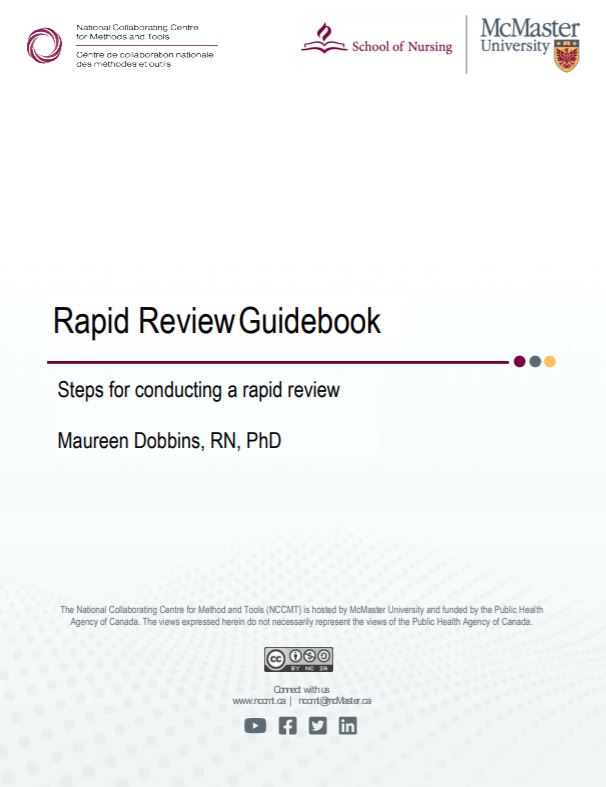Use the Right Review tool—a free, web-based resource that recommends the best review type for your project based on a few quick questions. Click the logo to get started.
Note: For a more comprehensive guide on rapid reviews, please go to our Rapid Review page within this guide.
Rapid reviews are a quick form of evidence synthesis. They seek to be “quick but not dirty” (Butler et al. 2005). They aim to be rigorous and reproducible but limit the scale of the search and the degree of appraisal to improve the turnaround time. A systematic review generally takes 12-18 months to complete, so a rapid review is often utilized when policy dictates a quick turnaround.
Browse the tabs at the top of this page to learn more about other types of evidence synthesis: Meta Analysis, Scoping Review, Rapid Review, and Umbrella Review.
Navigate the menu on the left for information on Systematic Searching Tips, Tools & Resources, and Library Help for your review.
 Rapid Review Guidebook: Steps for conducting a rapid review
by
Maureen Dobbin
The National Collaborating Centre of Methods and Tools (NCCMT) has developed a Rapid Review Guidebook that details each step in the rapid review process, with notes on how to tailor the process given resource limitations. The Guidebook also includes a guide to writing the final report, with details on how to structure the report and what to include in each section.
Rapid Review Guidebook: Steps for conducting a rapid review
by
Maureen Dobbin
The National Collaborating Centre of Methods and Tools (NCCMT) has developed a Rapid Review Guidebook that details each step in the rapid review process, with notes on how to tailor the process given resource limitations. The Guidebook also includes a guide to writing the final report, with details on how to structure the report and what to include in each section.
A scoping review is the broader counterpart to a systematic review. It is conducted similarly to a systematic review, but it aims to determine the size and/or scope of available research on a topic. A scoping review features a systematic and comprehensive search and should also be reproducible.
A scoping review should be no less rigorous than a systematic review, and is often an even bigger project than a systematic review, because the broader topic may lead to screening many more papers.
Browse the tabs at the top of this page to learn more about other types of evidence synthesis: Meta Analysis, Scoping Review, Rapid Review, and Umbrella Review.
Navigate the menu on the left for information on Systematic Searching Tips, Tools & Resources, and Library Help for your review.
An umbrella review compiles the evidence from multiple systematic reviews, you might think of it as a systematic review of systematic reviews. Systematic review production has skyrocketed during COVID, as it was a way for researchers to contribute to the scholarly literature while unable to access their lab, due to stay at home orders. This influx of systematic reviews will likely result in an increase in umbrella reviews.
Browse the tabs at the top of this page to learn more about other types of evidence synthesis: Meta Analysis, Scoping Review, Rapid Review, and Umbrella Review.
Navigate the menu on the left for information on Systematic Searching Tips, Tools & Resources, and Library Help for your review.
A systematic review aims to gather all of the randomized controlled trials on a specific intervention and determine what these studies have concluded, in combination. The resulting document is considered to be the strongest evidence one can use to make health decisions. In order to conduct a review, one must gather all the information, screen out anything that may be irrelevant, extract the data, and then draw conclusions.
What are some essential qualities of a systematic review? It should have a focused topic. If your research question is too broad, you’ll end up overwhelmed with the number of studies you must screen, and you’ll be unable to draw direct conclusions in the comparison of studies. Furthermore, it must have a systematic and comprehensive search. If your search isn’t comprehensive, you can’t claim to be synthesizing all the information. And finally, as with all research, your review must be reproducible. This means you must document and report every aspect of your search.
Browse the tabs at the top of this page to learn more about other types of evidence synthesis: Meta Analysis, Scoping Review, Rapid Review, and Umbrella Review.
Navigate the menu on the left for information on Systematic Searching Tips, Tools & Resources, and Library Help for your review.
A meta analysis is a statistical combination of the results of quantitative studies. A meta analysis must be conducted in conjunction with a systematic review, as the systematic searching for and screening of papers produces the list of studies used in a meta analysis. Therefore, every meta analysis must have a systematic review, but not every systematic review will have a meta analysis.

The data in a meta analysis are often visualized in a forest plot, which is featured above. Each row of the plot is a study, and the effect size and confidence intervals are also represented. You may have noticed, the Cochrane logo is a forest plot. That forest plot is from a review that changed clinical practice with regard to the use of corticosteroids in women at risk for pre-term birth.
Browse the tabs at the top of this page to learn more about other types of evidence synthesis: Meta Analysis, Scoping Review, Rapid Review, and Umbrella Review.
Navigate the menu on the left for information on Systematic Searching Tips, Tools & Resources, and Library Help for your review.
